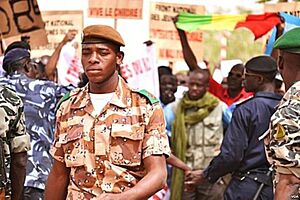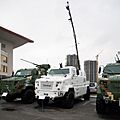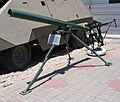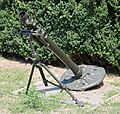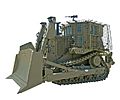Malian Armed Forces facts for kids
Quick facts for kids Malian Armed ForcesForces Armées Maliennes |
|
|---|---|
| Emblème des Forces Armées Maliennes (FAMa).svg |
|
| Established | 10 October 1960 |
| Parts | Malian Army Malian Air Force Malian Gendarmerie Republican Guard National Police (Sûreté Nationale) |
| Headquarters | Bamako |
| Leadership | |
| Commander-in-chief | Assimi Goïta |
| Minister of Defense | Minister of Defence |
| Chief of General Staff | Oumar Diarra |
| Serving soldiers | |
| Conscription | Compulsory military service |
| Active employees/soldiers | 40,000 plus 4,800 paramilitary forces |
| Expenditures | |
| Budget | $200-300 million ($5 million procurement) (FY03) |
| Percent of GDP | 3% (FY01) |
| Industry | |
| Suppliers from foreign countries |
|
| See also | |
| Ranks | Military ranks of Mali |
The Malian Armed Forces (known in French as Forces Armées Maliennes) are the military forces of the country of Mali. They include the Army, the Air Force, and the National Guard. These forces work to keep Mali safe and secure.
In 2009, there were about 7,350 soldiers in the Army, 400 in the Air Force, and 50 in the Navy. Other groups like the Gendarmerie and local police also help with security. Some Malian soldiers get special training in countries like the United States, France, and Germany. Mali also helps with peacekeeping missions in other African countries.
Contents
History of Mali's Military
How the Malian Army Started
The Malian Armed Forces began in 1960. Many of its first soldiers were Malians who had served in the French military. Before Mali's own army was formed, French military bases in Mali were closed down. For example, the base at Kati closed in June 1961.
On October 1, 1960, the Malian army was officially created. Captain Sekou Traore, the Chief of Staff, gave a speech to mark the occasion. A few days later, people in Bamako saw their new army parade for the first time. At the start of 1961, Mali's army had 1,232 soldiers.
Changes and Challenges Over Time
In the 1960s and 1970s, Mali's army and air force mainly got their equipment and training from the Soviet Union.
In 1968, a group of young Malian officers took control of the government without violence. They formed a military council with Lieutenant Moussa Traoré as its leader. They tried to improve the economy, but faced many challenges, including a severe drought. A new constitution in 1974 aimed to bring civilian rule, but the military leaders stayed in power.
In 1991, after several days of protests, a group of 17 military officers, led by Amadou Toumani Touré, took control. They set up a temporary government and started a process that led to democratic elections.
Dealing with Conflict
A conflict known as the Tuareg rebellion began in 1990. Tuareg groups attacked government buildings. The army's response led to a larger conflict. A big reason for the conflict was that Tuareg people felt they didn't have enough chances in the army. The fighting calmed down after Alpha Konaré became president in 1992. Mali created a new self-governing area called the Kidal Region and worked to include Tuareg people more in society.
In 2012, the Malian army faced major challenges against Tuareg separatists and other rebel groups. The rebels took control of a large part of Mali. Many soldiers were captured or left the army.
Because of this, a group of soldiers took control of the government in March 2012. They removed President Amadou Toumani Touré from power.
Rebuilding the Military
After these events, French forces helped to rebuild the Malian military. Now, the army is better equipped to fight against terrorism. In 2020, about 200 Malian troops were sent to Kidal, a northern city. This was the first time the army had been in that area since 2014, due to the Tuareg separatists. Since 2020, the military has also received new equipment from Turkey.
Malian Army Structure
The Malian Army gets its soldiers through a two-year selective conscription program. This means some young people are chosen to serve in the military. Mali has six military regions. For example, the 3rd Military Region is located at Kati, and the 5th Military Region is at Timbuktu.
In 2010, French forces helped train the 62nd Motorized Infantry Regiment, based at Sévaré. This regiment was considered one of the best parts of the Malian army.
Mali is also part of a group with Algeria, Mauritania, and Niger. They created a Joint Military Staff Committee in 2010 to work together on security in the Sahara region.
The Army also manages a small navy, which has about 130 sailors and three river patrol boats.
Military Training Schools
The Malian Armed Forces have important training centers:
- The Joint Military School in Koulikoro.
- The Alioune Blondin Beye Peacekeeping Training School in Bamako.
The Alioune Blondin Beye school trains soldiers for peacekeeping missions. It has trained over 6,900 students since it opened. Several countries and the ECOWAS (Economic Community of West African States) support this school.
Malian Air Force
The Mali Air Force (Armée de l'air du Mali) was started in 1961. It first received help from France, including transport planes. Later, in 1962, the Soviet Union provided more aircraft, such as biplane transports and helicopters. The Air Force used to fly MiG jets, but now it mainly uses cargo planes, light attack aircraft, and helicopters.
Images for kids


